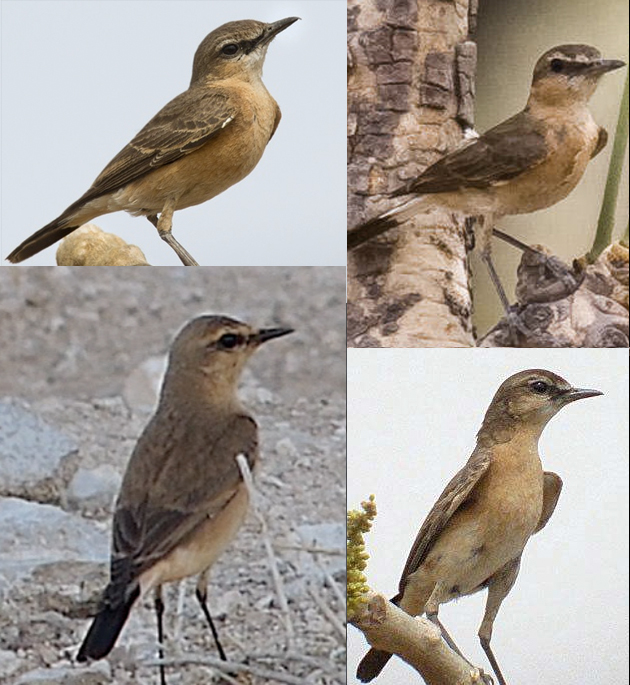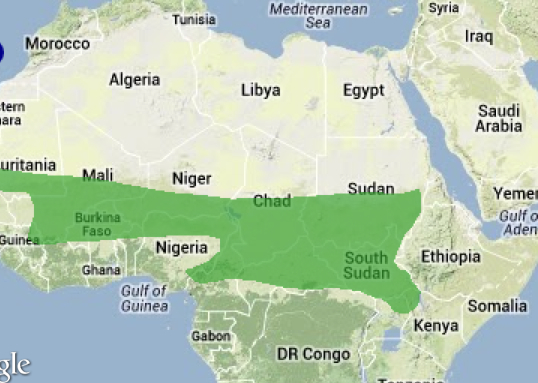From: Brian Finch <birdfinch@gmail.com>
Date: 2013-11-28 00:42
Subject: THE HEUGLIN’S WHEATEAR RECORD FROM BUFFALO SPRINGS
THE HEUGLIN’S WHEATEAR RECORD FROM BUFFALO SPRINGS
Dear All,
On 11th November, I posted on this net, the finding of a Heuglin’s
Wheatear at Buffalo Springs near the springs themselves. Since that
date I have done some research, and compared the bird with images of
Heuglin’s Wheatear across their sub-sahel range.
Wheatears are notoriously variable and the images that I have attached
show this.
The first set is of the Buffalo Springs bird revisited, and the next
set of four are three Heuglin’s from their sub-sahel range, and the
Buffalo Springs bird.
I have been through literally hundreds of images of Isabelline
Wheatears (see google images and you will be amazed at how many there
are in the public domain). All these images show the characterstic,
pallid creamy white underparts and pale sandy upperparts. No-where is
there a reddish bird photographed that resembles the bird at Buffalo
Springs, and none of the Isabelline Wheatears in the same area as this
bird varied from the norm. It might be said that as there had been
some rain, the birds might have been soil stained, but why only one
bird should be so affected would be very strange, and even more so as
it was on whitish clayey substrate anyway!
On comparing the images, it seems that the supercilium on the Buffalo
Springs bird is far more pronounced on the left side of the head than
the right. Apart from this whilst the three Heuglin’s Wheatears are
quite different from each other, all the features on the Buffalo
Springs bird are on at least one of them, nothing appears unique to it
except for one feature that I see, which possibly is leading me in the
direction of a strangely melanistic Isabelline rather than Heuglin’s.
A constant in the sub-sahel Heuglin’s images is that they all have
grey not black legs, the Buffalo Springs bird is decidedly
black-legged. Referring to Isabelline images, legs vary black to grey,
but in this sample of three Heuglin’s it is 100% grey. This then led
me to digging up images I had taken of Heuglin’s from Lokichoggio in
NW Kenya, where they are fairly common, and sure enough the legs were
grey. Image attached.
So if there are very rare examples of melanistic Isabelline Wheatear,
resembling almost perfect Heuglin’s Wheatears could it not have
happened before and an Isabelline mis-identified as a Heuglin’s. There
is only one Kenyan extralimital record of a bird seen in Kisumu, a
very strange record. This has been reported in the literature in our
regional publications, but I would suggest that the record is
revisited in view of the evidence we have now.
Just to add to the confusion, the Handbook states in the text that
both Heuglin’s and Isabelline Wheatears have black legs (no mention of
grey), and on the map there are four extralimital southern Kenyan
records not just the Kisumu bird. Incidentally this individual was
collected and must still be available for a re-examination somewhere.
It doesn’t end here, we have only touched on the appearance. The
Buffalo Springs bird, of which I have a video, is that most active
wheatear I think I have ever seen. Usually Isabellines have activity
in bursts, a run, stop, flick tail and/or wings, stop for a while and
repeat this often interspersing with short low flights. The BS bird
(for want of a better name!) never took wing. It ran (never hopped) in
very fast bursts, and on pausing wagged the tail up and down
furiously, it would have very rapid complete changes of directions but
all whilst running. It was an extremely active bird.
So whilst the record is withdrawn as a positive Heuglin’s Wheatear
record from Buffalo Springs, I guess you could say that the jury is
still out on this one!
Best for now
Brian







